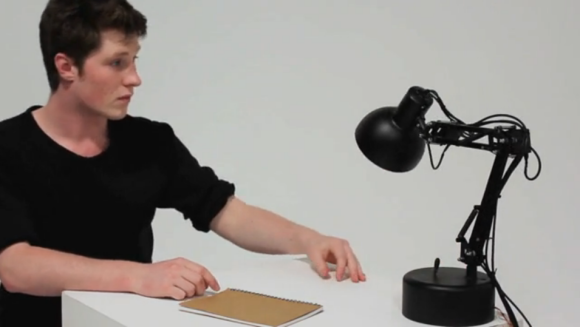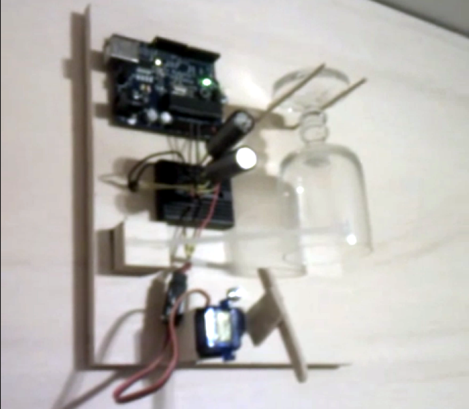servo
I tried to write a code but the servo would not stay so
Please can someone write a c++ code for arduio for me
I tried to write a code but the servo would not stay so
Please can someone write a c++ code for arduio for me






1 | /* ------------------------------------------------------- |



Even with the added hardware that lamp still looks relatively normal. But its behavior is more than remarkable. The lamp interacts with people in an incredibly lifelike way. This is of course inspired by the lamp from Pixar’s Luxo Jr. short film. But there’s a little bit of most useless machine added just for fun. If you try to shut it off the lamp shade is used to flip that switch on the base back on.
[Shanshan Zhou], [Adam Ben-Dror], and [Joss Doggett] developed the little robot as a class project at the Victoria University of Wellington. It uses six servo motors driven by an Arduino to give the inanimate object the ability to move as if it’s alive. There is no light in the lamp as the bulb has been replaced by a webcam. The image is monitored using OpenCV to include face tracking as one of the behaviors. All of the animations are procedural, making use of Processing to convey movement instructions to the Arduino board.
Do not miss seeing the video embedded after the break.
[via Gizmodo]

Hello all
I have renbotics ServoShield and I have made a code on arduino where from serialport I can send commads to servos and it happens with that way... S01P1200,S14P2300etc..I mean that Servo 1 to 1200 posion and servo 14 to 2300 posion
Hello all
I have renbotics ServoShield and I have made a code on arduino where from serialport I can send commads to servos and it happens with that way... S01P1200,S14P2300etc..I mean that Servo 1 to 1200 posion and servo 14 to 2300 posion

Rebuilt my lucky cat: whenever a page of my website is loaded, the cat will be waving its arm. There’s a light sensor so when its dark, the cats RGB-LED is changing the color instead of waving the arm. Changing the color of the LED is also possible with one of the buttons on the cats ears. The other one is the reset button. Used an arduino ethernet, a servo, two buttons, an RGB LED and two small yellow LEDs. The seven segment display is one that I harvested from an old stereo. It’s driven by the arduino and two shift registers. unfortunately I’ve soldered that one together for an older project, so that it doesn’t fit into the cat too. It shows the number of pageviews of the website.
via [instructables] visit the page of [Janwil]
The 12 DOF hexapod kit from DAGU is one of the simplest hexapod kits ever!
Quick and easy to assemble, the body only consist of 12 leg segments, 12 foam rubber feet, 12 servos and a base plate with a hole pattern that allows controllers and sensors to be easily mounted.

Hi, I'm new to LMR as a member. But I've been browsing around LMR to learn robotics. First, sorry for my bad English. I finished making my quadruped robot a couple weeks ago. It was my first robotic project using microcontroller. In fact, it was my first microcontroller project. Unfortunately it wasn't well documented during the making process since I didn't plan to publish it before. :( So here is what I can collect from scattered file in my PC..

Even if you live in a dump this quick build will make your doorbell sound high-class. The new rig uses a crystal goblet to alter you of guests at the door. We suppose the room-silencing sound of flatware on a wine glass does make a great attention getter.
For [Tobias] the hardest part of the build was getting his wife to sign off on it. But he says the 1970′s era original was looking pretty shabby, which kind of made his argument for him. It took just two hours to develop and install the replacement. It uses a servo motor with an articulated striker to ping the glass which is hanging inverted between two pegs. The original AC transformer (which are most often 16V) was used to power the Arduino. He built a simple rectifier along with a big smoothing capacitor to make sure the Arduino doesn’t reset when voltage dips. Although it’s not mentioned in his comments, we’d bet the doorbell wire has been rerouted to connect directly to the Arduino, rather than remain patched into the power loop.
Don’t miss the clip after the break to hear how great this thing really does sound.

Hi all,
I’ve been working on my first real robot last week-end and wanted to share it. It’s a simple quadruped arduino robot controlled by serial (via USB). Videos can be viewed on my blog : http://blog.joomun.org/2012/09/09/arduino-quadruped-robot/
The robot structure has been created with cheap mecanno clone
IR control has been added, i'll update the blog later.